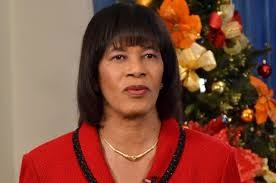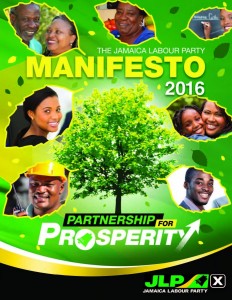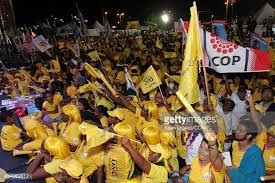 An analysis of poll numbers since 2014 and the number of eligible voters suggest that Thursday’s general elections in Jamaica could result in a shocker and a major shift in parliament. For the People National Party to win the 2016 elections will require voter turn out to be more than 50 percent.
An analysis of poll numbers since 2014 and the number of eligible voters suggest that Thursday’s general elections in Jamaica could result in a shocker and a major shift in parliament. For the People National Party to win the 2016 elections will require voter turn out to be more than 50 percent.
Polls done from late 2014 puts the Labour Party support consistently at 25 percent except for the temporary decline shown in the Don Anderson polls in January to 23.2 percent when political activity was low keyed. Based on error factors in past polls, the base for the JLP is around 28 percent which is consistent with polls done in 2015 that would give them 510,835 votes. This would be an increase of 105,677 over the 405,000 votes they received in 2011 and well over the 464,280 the PNP got then.
The increase for the Labour Party works out at an average of 1,682 votes per constituency and is likely to create a major change in the seat count. It is more difficult to say what the PNP numbers will work out at in the end but it should be at least close to their numbers for the last election. It is difficult to see voter turnout of 53 percent in the 2011 being exceeded by much if at all, which would put the PNP support at 25 percent of the electorate or a few thousand votes less than in 2011.
If the PNP does not increase their support by much, they will be relegated to the back benches of Parliament after Thursday’s polls.
Radio Jamaica increased profit
 Radio Jamaica increased profits for the quarter to June this year over that of 2014 by 44 percent after taxation, to reach $22 million from a 6 percent increase in sales revenues that hit $516 million. Other revenues contributed $25 million versus $20.7 million in 2014 to income.
Radio Jamaica increased profits for the quarter to June this year over that of 2014 by 44 percent after taxation, to reach $22 million from a 6 percent increase in sales revenues that hit $516 million. Other revenues contributed $25 million versus $20.7 million in 2014 to income.
RJR said that the provision of news services such as “Over the Top” (OTT) which relates to video, television and other services provided over the internet generated added revenues for them as well as added cost.
Administrative expenses jumped 15.4 percent to $126 million and selling expenses rose to $84.5 or 16.4 percent over the same period in 2014, the cost increase was partially due to the introduction of the OTT service, but wage increase and commission payments also contributed to the increase RJR said. Other operating expenses declined by $20 million to $79 million helped by lower energy and fuel cost.
The company reported earnings of 6 cents per share for the quarter and 32 cents for 2015 fiscal year and seems headed to earn 40 cents for the fiscal year ending March 2016. There is talk of general elections being held soon although that is just talk, with no concrete evidence to support it and with several developments in the country suggesting it may be later in 2016, that is will be held. Whenever it is held, RJR will benefit from added revenues as well as increased cost covering the event.
RJR entered into an agreement with the Gleaner to merge the two media operations which will involve RJR splitting the number of existing issued shares into approximately three and for the Gleaner shareholders to get 1 of the new RJR shares for each Gleaner share. If successful the expanded RJR should see reduction in cost as certain areas are combined thus reducing cost and should result in an improved profit per share going forward. It probably won’t be until the 2017 fiscal year that full effect of the merger will be seen.
RJR last traded on the Jamaica Stock Exchange at $3.08 but had a bid at $3.50.
 The conventional wisdom, according to political pundits, is that a high turnout for elections favours the challengers and a low one, the government, but they don’t really say what is a low turnout? The latest polls show
The conventional wisdom, according to political pundits, is that a high turnout for elections favours the challengers and a low one, the government, but they don’t really say what is a low turnout? The latest polls show  Jamaican pollsters have consistently failed to accurately predict the out turn in
Jamaican pollsters have consistently failed to accurately predict the out turn in  That poll result released on the Sunday ahead of the polls showed a voter turnout of 74 percent, a level that Trinidad and Tobago has not seen since 1961. In the 2010 elections, the turnout was 69.45 percent, 66.03 percent in 2007 and 69.64 percent in 2002, next closet was 1991 with 65.76 percent. IC Insider stated that based on the pattern of recent years it would be surprising if the turnout exceeded 70 percent and that could make a huge difference to the final election results. In the end the turnout fell well below 70 percent, at 66.84.
That poll result released on the Sunday ahead of the polls showed a voter turnout of 74 percent, a level that Trinidad and Tobago has not seen since 1961. In the 2010 elections, the turnout was 69.45 percent, 66.03 percent in 2007 and 69.64 percent in 2002, next closet was 1991 with 65.76 percent. IC Insider stated that based on the pattern of recent years it would be surprising if the turnout exceeded 70 percent and that could make a huge difference to the final election results. In the end the turnout fell well below 70 percent, at 66.84.




